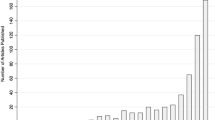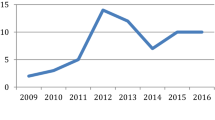Abstract
This article examines the process by which vulnerability analysis takes place at the state level for State Hazard Mitigation Plans, as required by the Disaster Mitigation Act of 2000. The methods developed by the Center for Hazards Research and Policy Development at the University of Louisville are described, followed by a brief discussion on issues and challenges. A key finding in this article is the need to understand the impact and role of vulnerability analysis on planning and policy-making at the state and local level, as it applies to the investment of funding and resources in hazard mitigation. Recommendations for policy as well as directions in future research are offered in conclusion.








Similar content being viewed by others
References
44 CFR 201. Code of Federal Regulations for the Disaster Mitigation Act of 2000. Federal Register, USA
Adger NW, Brooks N, Bentham G, Agnew M (2004) New indicators of vulnerability and adaptive capacity. Tyndall Centre for Climate Change Research, School of Environmental Science, East Anglia, UK
Bankoff G, Frerks G, Hilhorst D (2004) Mapping vulnerability: disasters, development, and people. Earthscan, London
Blaikie P, Cannon T, Davis I, Wisner B (1994) At risk: natural hazards, people’s vulnerability, and disasters. Routledge, London
Cannon T (2000) Vulnerability analysis and disasters. In: Parker DJ (ed) Floods. Routledge, London
Chakraborty J, Graham TA, Burrell EM (2005) Population evacuation: assessing spatial variability in geophysical risk and social vulnerability to natural hazards. Nat Hazards Rev 6:23–33
Church TJ, Cova RL (1997) Modelling community evacuation vulnerability using GIS. Int J Geogr Inform Sci 11:763–784
Cutter S, Boruff BJ, Shirley WL (2003) Social vulnerability to environmental hazards. Soc Sci Q 84:243–261
Dolan AH, Walker IJ (2004) Understanding vulnerability of coastal communities to climate chance and related risks. J Coastal Res SI 39
Flax LK, Jackson RW, Stein DN (2002) Community vulnerability assessment tool methodology. Nat Hazards Rev 3(4):163–176
King D (2001) Uses and limitations of socioeconomic indicators of community vulnerability to natural hazards: data and disasters in Northern Australia. Nat Hazards 24:147–156
Menomi S, Meroni F, Pergalani F, Petrini V, Luzi L, Zonno G (2000) Measuring the seismic vulnerability of strategic public facilities: response of the health-care system. Disaster Prev Manage 9:29–38
Morrow BH (1999) Identifying and mapping community vulnerability. Disasters 23:1–18
Odeh DJ (2002) Natural hazards vulnerability assessment for statewide mitigation planning in Rhode Island. Nat Hazards Rev 3(4):177–187
Paton D, Johnston D (2001) Disasters and communities: vulnerability, resilience and preparedness. Disaster Prev Manage 10:270–277
Rygel L, O’Sullivan D, Yarnal B (2005) A method for constructing a social vulnerability index: an application to hurricane storm surges in a developed country. Mitigat Adapt Strat Global Change 11(3):741–764
State of Kentucky, Division of Emergency Management (2007) Kentucky State Hazard Mitigation Plan, November 2007. Written by the Center for Hazards Research and Policy Development, University of Louisville, Louisville, Kentucky, 275 pp
Tapsell SM, Penning-Rowsell EC, Tunstall SM, Wilson TL (2002) Vulnerability to flooding: health and social dimensions. Phil Trans R Soc Lond 360:1511–1525
Wei Y, Fan Y, Lu C, Tsai H (2004) The assessment of vulnerability to natural disasters in China by using the DEA method. Environ Impact Assess Rev 24:427–439
Author information
Authors and Affiliations
Corresponding author
Rights and permissions
About this article
Cite this article
Simpson, D.M., Human, R.J. Large-scale vulnerability assessments for natural hazards. Nat Hazards 47, 143–155 (2008). https://doi.org/10.1007/s11069-007-9202-6
Received:
Accepted:
Published:
Issue Date:
DOI: https://doi.org/10.1007/s11069-007-9202-6




